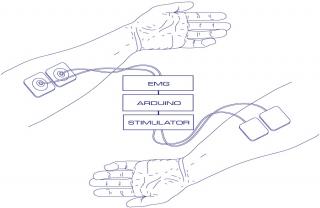Human Puppets
Alex Dodge
Ezer Lichtenstein
Johnny Lu
Stepan Boltalin
Human muscle movements controlled by other humans via interactive device.
http://itp.nyu.edu/~ad1790/blog/?p=457

The underlying concept for the Human Puppets is fairly simple: taking the reading function of the EMG (electromyograph) and applying it to a write function. The medium being controlled: human muscle tissue. Thus anybody, who is interested of giving control over his body to another human being can be turned into a human puppet and then switch the roles with his "master".
Background
Expanding the EMG circuit worked on previously by Ezer Longinus and Alex Dodge we rewrote code making the EMG read more reliable and stable. This signal was used to drive an optoisolator (an LED coupled with a photo sensor) which in turn regulated the output from our muscle stimulator. This signal pathway proved on a somewhat crude level that muscle activity read from one location (person A) and could be transmitted to a second location (person B) and in effect “written” into a similar action by corresponding placement of electrodes.
The TENs unit used for prototyping was the original medical device, which was later replaced with PCB-based device, based on schematics from Silicon Chip Magazine.
Audience
Any people interested in biological feedback and/or closing the gap between biology and technology.
User Scenario
Users approach the table, where the project is being showcased. For the safety reasons the demonstrations are made by two of group members, who have already tested the project on various stages. After the demonstration is made, users may experience the human puppetry themselves. It is still in question, wether users should be able to do only the input part (so no signals are run through guests bodies), leaving puppet's role to one of group members.
Implementation
Human Puppets consists of:
1) Input - EMG (electromyograph unit), which takes reading from one person's A muscles.
2)Output - TENS unit, which outputs signal through electrodes connected to person's B muscles, thus causing contraction of muscles.
3)Arduinos.
4)Screen which shows simple visualization of signals.
Conclusion
We went through 3 different TENs circuits before actually finding the right one. All the circuits are built on PCBs, which are going to be a part of exterior design of a final product.
The process of creating the prototype can be seen on a video, submitted to this page (as a link to Vimeo).
Background
Expanding the EMG circuit worked on previously by Ezer Longinus and Alex Dodge we rewrote code making the EMG read more reliable and stable. This signal was used to drive an optoisolator (an LED coupled with a photo sensor) which in turn regulated the output from our muscle stimulator. This signal pathway proved on a somewhat crude level that muscle activity read from one location (person A) and could be transmitted to a second location (person B) and in effect “written” into a similar action by corresponding placement of electrodes.
The TENs unit used for prototyping was the original medical device, which was later replaced with PCB-based device, based on schematics from Silicon Chip Magazine.
Audience
Any people interested in biological feedback and/or closing the gap between biology and technology.
User Scenario
Users approach the table, where the project is being showcased. For the safety reasons the demonstrations are made by two of group members, who have already tested the project on various stages. After the demonstration is made, users may experience the human puppetry themselves. It is still in question, wether users should be able to do only the input part (so no signals are run through guests bodies), leaving puppet's role to one of group members.
Implementation
Human Puppets consists of:
1) Input - EMG (electromyograph unit), which takes reading from one person's A muscles.
2)Output - TENS unit, which outputs signal through electrodes connected to person's B muscles, thus causing contraction of muscles.
3)Arduinos.
4)Screen which shows simple visualization of signals.
Conclusion
We went through 3 different TENs circuits before actually finding the right one. All the circuits are built on PCBs, which are going to be a part of exterior design of a final product.
The process of creating the prototype can be seen on a video, submitted to this page (as a link to Vimeo).


